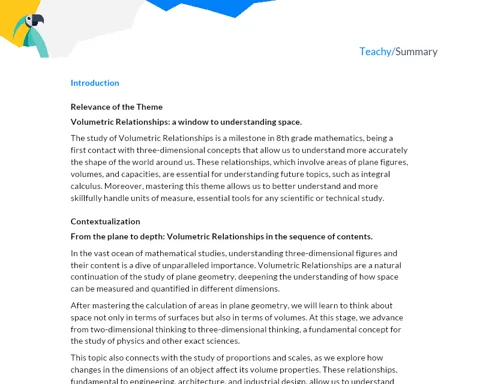Introduction
The Relevance of the Subject
Understanding the area of a trapezoid is a fundamental extension of geometry. Grasping the area of flat figures, such as the trapezoid, is essential not only for mathematics but for numerous applications in fields like engineering, architecture, graphic arts, and even economics. Therefore, by learning about trapezoids and how to calculate their area, you are acquiring a powerful tool that proves useful in countless practical situations.
Contextualization
Fitting into the vast universe of Geometry, studying the area of a trapezoid complements the understanding of areas of flat figures and strengthens logical and abstract reasoning. This topic arises after the study of triangles, quadrilaterals, and parallelograms, providing an alternative way to calculate the area of flat figures.
Moreover, the trapezoid can also be used as a bridge to the study of three-dimensional shapes, as from it we can extract a solid known as a frustum of a pyramid. Thus, the trapezoid is a key element in the mathematical curriculum, facilitating subsequent advances in geometry and calculus applications.
Theoretical Development
Components
-
Larger Base (a): It is the longest side of the trapezoid, usually called the larger base. It is fundamental for area calculation, as it defines the 'width' of the figure in relation to which the height will be measured.
-
Smaller Base (b): It is the shortest side of the trapezoid, also called the smaller base. Along with the larger base, it defines the shape of the trapezoid.
-
Height (h): The height of the trapezoid is the perpendicular distance between the two bases. It is essential for area calculation, as it defines the 'vertical extension' of the figure.
Key Terms
-
Trapezoid: It is a quadrilateral that has at least one pair of parallel sides. The bases of the trapezoid are the two parallel bases.
-
Area: It is a measure that expresses the extension of a flat surface or a closed plane. In the case of the trapezoid, the area is calculated by the product of the sum of the bases by the height, divided by 2.
Examples and Cases
-
Example 1: Given a trapezoid with a larger base measuring 10 cm, a smaller base measuring 6 cm, and a height of 4 cm. To calculate the area, we use the formula: Area = (larger base + smaller base) x height / 2 = (10 + 6) x 4 / 2 = 16 x 4 / 2 = 64 / 2 = 32 cm². Therefore, the area of this trapezoid is 32 cm².
-
Example 2: Now, we have a trapezoid with a larger base measuring 15 m, a smaller base measuring 9 m, and a height of 6 m. Following the area formula, we have: Area = (larger base + smaller base) x height / 2 = (15 + 9) x 6 / 2 = 24 x 6 / 2 = 144 / 2 = 72 m². Therefore, the area of this trapezoid is 72 m².
-
Interesting Case: Imagine a plot of land in the shape of a trapezoid, with bases measuring 30 m and 20 m, and a height of 10 m. To determine the amount of grass needed to cover the entire plot, we need to calculate the area of the trapezoid. Using the formula, we have: Area = (larger base + smaller base) x height / 2 = (30 + 20) x 10 / 2 = 50 x 10 / 2 = 500 / 2 = 250 m². Therefore, we need 250 m² of grass to cover the entire plot.
Detailed Summary
Key Points
-
Trapezoid Definition: The trapezoid is a flat figure characterized by its two parallel sides. These parallel sides are called bases, one larger and one smaller.
-
Key Elements of the Trapezoid: Understanding the trapezoid requires comprehension of its elements: the two parallel bases and the height. The larger and smaller bases determine the 'degree of elongation' of the trapezoid, while the height measures the 'vertical span'.
-
Trapezoid Area: The area of the trapezoid is calculated by multiplying the sum of the bases by the height and dividing the result by 2. This formula demonstrates the essential relationship between the elements of the trapezoid and its area.
Conclusions
-
Universal Area Formula: The universal area formula, which is the sum of the bases multiplied by the height and divided by 2 (A = (b + B) * h / 2), is also applicable to the trapezoid, demonstrating that it is a figure that fits into the vast universe of Geometry.
-
Practical Applicability: The ability to calculate the area of a trapezoid is not just a theoretical topic, but something that has practical application in various industries and professional fields.
Suggested Exercises
-
Theoretical Exercise: Calculate the area of a trapezoid with a larger base of 12 cm, a smaller base of 8 cm, and a height of 6 cm.
-
Practical Exercise: Consider a plot of land whose dimensions form a trapezoid, with a larger base of 15 m, a smaller base of 10 m, and a height of 12 m. Calculate the area of the plot in square meters.
-
Challenge: Given the area of a trapezoidal plot of land which is 96 m², the non-parallel sides of the land measure 12 m and 8 m, and the height is 8 m. Determine the measurement of the larger base and the smaller base of the land.



